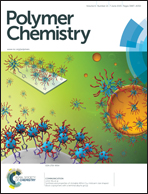Electrochemical synthesis of polymer microgels†
Abstract
We describe an electrochemical approach for the synthesis of polymer microgels through polymerization of the monomer in the presence of the crosslinker. This electrochemical approach means initiation by the electron transfer processes which occur at the electrodes, in that by controlling the applied potential it is possible to control the generation of free radicals and/or other reactive species. Upon applying a suitable potential above the electrochemical oxidation waves of N-isopropylacrylamide (as a model of the monomer) and N,N′-methylenebisacrylamide (as a model of the crosslinker), the polymerization and crosslinking are able to proceed to obtain nearly monodisperse polymer microgels with high yield. The apparent rate constant was determined to be 1.69 × 10−2 min−1 based on the evolution of light scattering intensity, or 1.43 × 10−2 min−1 based on the average hydrodynamic diameter. The underlying formation mechanism to reach polymer microgels instead of macrogels, even at high monomer concentrations, is possibly due to the limitation of the primary chain length such that bridging between growing microgel regions can be eliminated. The microgel size can be tuned by varying the applied potential. The reaction medium can be recycled, and reused directly without a notable impact on the next cycle of synthesis. This electrochemical approach can be extended to synthesize microgels of poly(acrylamide) or poly(acrylic acid) (as the additional models).


 Please wait while we load your content...
Please wait while we load your content...